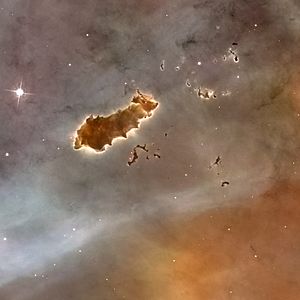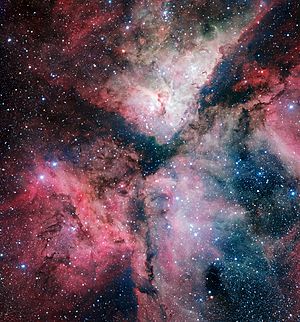Bart Bok facts for kids
Quick facts for kids
Bart Bok
|
|
|---|---|

Bok in his final year, 1983
|
|
| Born |
Bartholomeus Jan Bok
April 28, 1906 Hoorn, Netherlands
|
| Died | August 5, 1983 (aged 77) Tucson, Arizona, United States
|
| Nationality | Dutch-American |
| Citizenship | American |
| Alma mater | Leiden; Groningen |
| Known for | The Milky Way; Bok globules |
| Spouse(s) | Priscilla Fairfield Bok |
| Children | Joyce and John |
| Scientific career | |
| Fields | Astronomy |
| Institutions | |
| Doctoral students | Elske Smith |
Bartholomeus Jan "Bart" Bok (born April 28, 1906 – died August 5, 1983) was a famous astronomer, teacher, and speaker from the Netherlands who later became an American citizen. He is best known for his important work on our home galaxy, the Milky Way. He also discovered tiny, dark clouds in space called Bok globules. He thought these clouds were where new stars were forming.
Bart Bok married another astronomer, Priscilla Fairfield, in 1929. They worked together so closely that it was hard to tell their achievements apart. They were both very excited about sharing astronomy with everyone. People even called them "salesmen of the Milky Way" because they were so good at it!
Together, they wrote a popular book called The Milky Way. It was published five times and was loved by many people. Bart Bok loved studying our galaxy. He once wrote that he had been a "happy astronomer" exploring the Milky Way for sixty years.
Bart Bok was also known for being a friendly and funny person. When an asteroid was named 1983 Bok after him and Priscilla, he joked that he finally had "a little plot of land" to retire to.
Contents
Bart Bok's Early Life and Studies (1906–1929)
Bart Bok was born in a small town called Hoorn in the Netherlands. His father was a soldier. Bart spent a lot of his childhood with his grandparents in Haarlem, where he went to primary school. He was very good at math and science in high school. He also said that his Scoutmaster taught him about the night sky during camping trips.
After high school, he went to Leiden and Groningen Universities to study astronomy. In 1928, he met Priscilla Fairfield at a big astronomy meeting in Leiden. She was an astronomy professor. Bart was a student, ten years younger than her. He fell in love and asked her to marry him at the end of the meeting. Priscilla didn't say yes right away, but after a year of letters, she finally agreed.
The next year, Bart moved to the United States. He was invited by Harlow Shapley, who was the director of the Harvard College Observatory. Bart and Priscilla got married on September 9, 1929, just two days after he arrived in the US.
Working at Harvard University (1929–1957)
The Boks stayed at Harvard University for almost 30 years. Bart taught astronomy and helped lead the Harvard Observatory. He earned his doctoral degree in 1932. He became a full professor in 1947. Priscilla also did her own research and wrote with Bart. However, she was not paid for her work at first.
Bart and Priscilla had two children: a son named John in 1930 and a daughter named Joyce in 1933. Priscilla stayed home until their children finished high school. Even so, she always helped Bart with his research and public events. When Bart became an American citizen in 1938, he shortened his first name to "Bart."
Their marriage was the start of a strong scientific partnership. They wrote many papers together about star clusters and the structure of the Milky Way. Bart was very interested in how star clusters and galaxies form. He showed that our galaxy might be about 20 billion years old.
They loved sharing astronomy with the public. Their book, The Milky Way, was a very successful astronomy book. It was translated into many languages. Bart said that writing the book together was sometimes hard, but they made it work.

In the 1940s, Bart Bok first saw small, dark clouds of gas and dust in the Milky Way. These clouds later became known as Bok globules. In 1947, Bok and E.F. Reilly thought these clouds were like "insect cocoons" where new stars were being born. It was hard to prove this idea at first because the clouds were so dense. But after Bok passed away, scientists used new tools to see inside the clouds. They confirmed that stars were indeed forming inside Bok globules.
The Bok family also helped set up observatories in other countries. In 1941, Bart helped create the Tonantzintla Observatory in Mexico. In 1950, he set up a special telescope in South Africa. While there, he and Priscilla studied stars in the southern sky, including Eta Carinae, which was the topic of Bart's doctoral work.
Bart Bok was also one of the first to believe that combining radio astronomy (studying radio waves from space) and optical astronomy (studying visible light) would be very helpful. This idea was important for understanding what happens inside Bok Globules.
Moving to Australia (1957–1966)
In 1957, the Boks moved to Australia. Bart became the Director of Mount Stromlo Observatory in Canberra. He helped Australian astronomy grow a lot. He started a program for graduate students that was so good, it was called "Harvard in the South." He also got money from the Prime Minister to build a new telescope and set up another observatory at Siding Spring.
Bart was a pioneer in using computers for astronomy. In 1960, he had the first computer installed at the observatory. He also used television to share astronomy with many people in Australia. This helped more people learn about and support astronomy.
Mount Stromlo became a top observatory. But Bart knew that the location had problems with weather and light pollution. So, he started looking for a better place. In 1962, Siding Spring Mountain was chosen for a new, world-class telescope. Bart supported building Australia's largest optical telescope there, the Anglo-Australian Telescope.
During this time, Priscilla spent many nights observing and analyzing data at the telescopes. She was more interested in basic observations like finding star positions. Their different personalities helped their scientific work. Priscilla's calm nature balanced Bart's energetic one.
Bart was always eager to promote astronomy to the public. He tried to give three public talks every month. He would talk in cities and in the countryside. He often spoke at high schools too. This helped get support for big, expensive projects like the Anglo-Australian Observatory. He didn't get to see it finished, but his efforts made it happen.
Returning to the US (1966–1983)
In 1966, the Boks moved back to the US. Bart became the Head of the Astronomy Department at the University of Arizona and Director of Steward Observatory. He helped build a large telescope at the Kitt Peak National Observatory. Under his leadership, the university's astronomy staff doubled, and the graduate student program grew. By 1970, Steward Observatory was one of the best in the world.
After 1970, Bart became more involved in big astronomy organizations. He was vice-president of the International Astronomical Union (IAU) and president of the American Astronomical Society (AAS).
Priscilla had a stroke in 1972, and her health got worse. Bart resigned from his positions in 1974 to take care of her. She passed away in November 1975.
In 1975, Bart Bok helped write a statement called Objections to Astrology. Many scientists, including Nobel Prize winners, supported it. This statement helped start a group called the Committee for the Scientific Investigation of Claims of the Paranormal. Bart was a founding member. He was later named one of the "outstanding skeptics of the twentieth century."
Bart continued as a professor at the University of Arizona. He also went on trips to see solar eclipses. His last eclipse trip was to Java in June 1983. Bart Bok died of a heart attack at his home in Tucson, Arizona, a little over a month after that trip.
Honors and Legacy
Bart Bok received many honors for his work.
- Important Positions
- Vice-president of the International Astronomical Union (1970–74)
- President of the American Astronomical Society (1972–74)
- Elected to the US National Academy of Sciences (1968)
- Honorary Member of the Royal Astronomical Society of Canada
- Honorary Member of the Astronomical Society of Australia
- Honorary Member of the Royal Astronomical Society of New Zealand
- Corresponding member of the Royal Netherlands Academy of Arts and Sciences
- Associate Fellow of the Royal Astronomical Society, London
- Awards
- Adion medal (1971) from France
- Jansky Prize (1972) for great contributions to radio astronomy.
- Knight in the Order of Orange-Nassau
- Catherine de Wolfe Bruce Medal (1977)
- Henry Norris Russell Lectureship (1982) for a lifetime of excellent astronomical research.
- Klumpke-Roberts Award (1982) for helping the public understand astronomy.
- Named After Him
- Lunar crater Bok on the Moon (named with his wife Priscilla)
- Asteroid 1983 Bok (named with his wife Priscilla)
- Bok globules
- Bok Telescope - the Steward Observatory's 90-inch (2.3 m) telescope was named after him in 1996.
- C/1949 N1 - A comet that Bok helped discover.
- Memorial Awards
- Bart J Bok Postdoctoral Fellowship, given by the University of Arizona.
- The Bok Prize is given every year by the Astronomical Society of Australia for great astronomy research by students.
- Another Bok Prize is given by Harvard University for research on the Milky Way.
- Two Priscilla and Bart Bok Awards are given each year by the Astronomical Society of the Pacific and the American Astronomical Society to science fair projects. These awards honor the Boks' work in astronomy education.
Selected publications
- Bok's ADS record.
See also
 In Spanish: Bart Bok para niños
In Spanish: Bart Bok para niños


